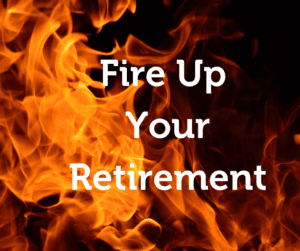Is it time to FIRE up your retirement?
It’s been a number of years since I last wrote about the Financial Independence Retire Early (FIRE) approach to retirement. There are now a number of different FIRE models with the same eventual goal of achieving financial independence. Hopefully knowing other people’s path may inspire you to choose an option more aligned with your personal values and circumstances.
The original FIRE version is an interesting contrast with the traditional retirement model of work for forty years to retire at age 65 and then start living for the next couple of decades. Under the original FIRE model, people would save a significant amount of their income (50 percent wasn’t unusual) in order to increase their net worth as quickly as possible to then live off the principal and income for the rest of their lives. They often minimized their expenses so they wouldn’t need to accumulate as much. The allure was they didn’t have to wait until an arbitrary age of 65 to pursue their dreams.
One side effect of this approach is people would work as much as possible to maximize their income during their 20s and 30s resulting in less time to pursue other life goals when they had the most energy and good health. In response to this, the idea of “Slow FI” developed to still achieve financial independence but with a less aggressive timeline.
Slow FI allows people to pursue other interests along the way and use some of their wealth prior to achieving full financial independence. Slow FI utilizes a lower savings rate to spend more now. Anyone with regrets on their deathbed will tell you this approach is better than waiting until a day that may never come to pursue your dreams. The main difference between Slow FI and the traditional retirement model is being more intentional with how you spend your time and money along the way.
A third approach attractive to people who want to continue working at a reduced level is the “Coast FI” movement. This approach requires saving a certain amount of money by a specific age with the intention of letting it grow but without additional contributions. This allows people to reduce their income since they’re not allocating 20 percent or more to savings. They can pursue less lucrative careers that generate enough income to cover their living expenses without the need to worry about whether they’ll ever be financially independent since their portfolio is growing in the background.
A final approach is “Barista FI” which is based on not saving enough to be completely financially independent through portfolio income because you’re also earning a modest amount of income (in other words working at Starbucks) to cover the remaining living expenses (and perhaps health insurance). There’s overlap between these various approaches and people can alternate depending on their particular circumstances. For example, someone who started under the original FIRE model may find themselves burned out before achieving financial independence and consciously change to the Coast FI or Barista FI model until they’re ready to exit the workforce.
While as a financial planner, I can’t help but raise an eyebrow at some of the assumptions people use in their calculations (withdrawing 4 percent for 50+ years?), I love the idea of considering different approaches to living your great life.






